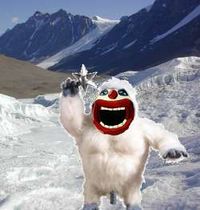Dabbi
The Dabbĩ (Pronounced Daaahhbeee) is an ancient Icelandic folklore tale. Often likened to The Abominable Snowman, Bigfoot, and Sasquatch, it is rumoured to be 10 – 14 feet tall, covered in white fur, with hands the size of seals.
There are many references to Dabbĩ, in modern Icelandic customs. To this day whenever a toast is given (particularly in northern coastal areas) ‘Prőőg’ is announced and glasses are tipped left-handed in respect for Dabbĩ.
Many scholars have devoted their lives learning about the origins of Dabbĩ, yet little is known of his background, where he came from or where he went to. Stories and tales are passed through the generations, father to son, mother to daughter.
Beginnings of Myth[edit | edit source]
Dabbĩ was very much a fable in 900 ad Iceland. Many had claimed to have sighted him, but few were able to prove it. Many fishermen fishing close to the shoreline, claimed to have see his huge figure by the waters edge. They claim to have seen him picking up seals, three at a time and devouring them in one mouthful. With no attacks on the inhabitants of northern Iceland, and due to the remoteness of his whereabouts, Dabbĩ maintained a solitary existence for much of his life.
Vikings Attack[edit | edit source]
In 1060 the Vikings attacked Iceland. An enormous fleet of Norse long-boats landed at many ports at once. Iceland was in total disarray, not knowing where to protect first. After three days, Iceland was over thrown, many of its men killed in battle. A deal was done whereby if Iceland surrendered to Klăăărnod, a fierce Viking ruler, then there would be no more bloodshed.
The Icelandic peasants agreed to this, and once more peace reigned, albeit at a price, their freedom. Klăăărnod and his brother Hăg introduced many changes to Iceland. They introduced shoes, beer and basic writing techniques. Many saw these as improvements, but many still saw the invaders as sworn enemies. A small division of dissident Icelanders retreated to the hills to escape the Vikings. From there, they plotted to overthrow these Norsemen who had taken their women and made them wear shoes. The Vikings sent their best warriors to hunt them down like dogs. They retreated further into the wilderness, and were not seen again for two years. Banto the leader of the dissidents regularly planned attacks on the Norse strongholds, but none were effective. His people were losing faith in him. They were weak from eating moss, and many considered surrender as their only option. All of them returned to Ölfusá , Landmannalaugar and Latrabjarg, the main Norse strongholds to beg for their lives. Many of them were spared , although it is widely believed that two of the senior members were fed to the dogs, to make an example of them to any other would-be insurgents.
Transvestite[edit | edit source]
Disguised as a dead swan Banto observed this massacre from within the village of Latrabjarg.
Weeping, he left the village and he walked north to Ruafarhofn. He sat there for thirty days looking out to the sea, praying that his country would be free from the tyranny of the Vikings. Eventually he lay on a rock by the sea. He was nearly dead from starvation and a general hopelessness. He closed his eyes and knew it was all over. That night Dabbĩ approached him, thinking he was a seal. When he spotted Banto he approached him with caution. Banto woke, paralysed with fear when he saw Dabbĩ’s hulking figure. He prayed out loud that he wouldn’t die this way. Dabbĩ picked Banto up, and carried him away. He walked and walked and walked. Banto lost consciousness from the fear he experienced. When he woke he heard voices and women and children screaming. He looked out from Dabbĩ’s huge arms, and noticed that they had walked into the village of Ölfusá. The Viking soldiers gathered to assess the situation. Dabbĩ let Banto down onto the ground and stood in the centre of the village. There was silence. Suddenly Dabbĩ let an enormous roar, and attacked the Vikings. They were useless against his sheer ferociousness. One by one he literally tore the Viking enemies apart. More Vikings came but they met the same ending as their allies. After one days fighting, the remaining Vikings fled to their long-boats to escape Dabbĩ.
Fan Dabbi Dozy[edit | edit source]
The villagers cheered Dabbi as he massacred their enemies. When it was all over, Dabbi collected the Viking heads. He carried the heads by the hair to the shore and arranged them in a line. Then he took a few steps back and literally kicked each head into the sea. Many of the heads hit the retreating Long-boats, adding to the fear that they were already experiencing. Just as St. Patrick drove the snakes from Ireland, it is widely believed that Dabbĩ drove the Vikings from Iceland, never to return.
Dabbĩ left the spot shortly after, walking north along the coast, never to be seen again.
Yabbi Dabbi Day[edit | edit source]
There is no official Dabbĩ day in Iceland, but many fishermen celebrate May 9th. No fishing takes place this day, in respect of Dabbĩ. One of the customs is to bring a dead seal to the rock where Dabbi discovered Banto. This is seen as extremely good luck for the fishing year ahead.
Heads[edit | edit source]
Today, many naughty Icelandic children are warned that if they don’t go to sleep on time, then Dabbĩ will come and remove their head….an old wives tale rooted deep in Icelands past.


